The Rhysida ransomware-as-a-service (RaaS) group has gone from a dubious newcomer to a fully-fledged ransomware operation. Despite the developer’s partial implementation of some features, the group emerged onto the scene at the end of May with a high-profile attack against the Chilean Army, continuing the ongoing trend of ransomware groups targeting Latin American government institutions. On June 15, the group leaked the files stolen from the Chilean Army.
In this post, we provide a high-level overview of Rhysida ransomware activity and present technical details of the malware payloads, along with hunting rules and IoCs to aid threat hunters and security teams.

Recent Attacks Attributed to Rhysida
On May 29 2023, the Chilean Army reported that it had been the target of a cyberattack affecting the organization’s internal network on Saturday, May 27. The attack was later attributed to Rhysida.
Strategically, the Rhysida group’s attack against the army of Chile distinguishes this newcomer from the sea of ransomware newcomers. It should be noted that Rhysida is an apparently independent ransomware group: SentinelOne has not observed any overt connections to existing ransomware operations. As such, any potential geopolitical ramifications from attacking Chile’s government are as yet unclear. This is not the first time a Chilean governmental organization has been compromised by a new ransomware family, as demonstrated by the ARCrypter attack in November 2022.
The attack was followed by the leaking of data belonging to the army on June 15th. Through the week of June 19 2023, Rhysida’s leaks page displayed an influx of further victims, including multiple organizations in each of the following sectors:
- Education
- Government
- Manufacturing
- Technology and Managed Service Providers (MSP)
Victims are distributed throughout Western Europe, North & South America, and Australia, loosely aligning the group’s targeting with many ransomware operations that avoid targeting countries in Eastern Europe and Central Asia’s Commonwealth of Independent States. There are no Asian organizations posted at this time.
Operational Overview
The Rhysida ransomware group was first observed in May of 2023, following the emergence of their victim support chat portal, hosted via TOR (.onion). The name “Rhyshida” refers to a specific genus of centipede. This is also reflected in the ‘branding’ on their victim blog.
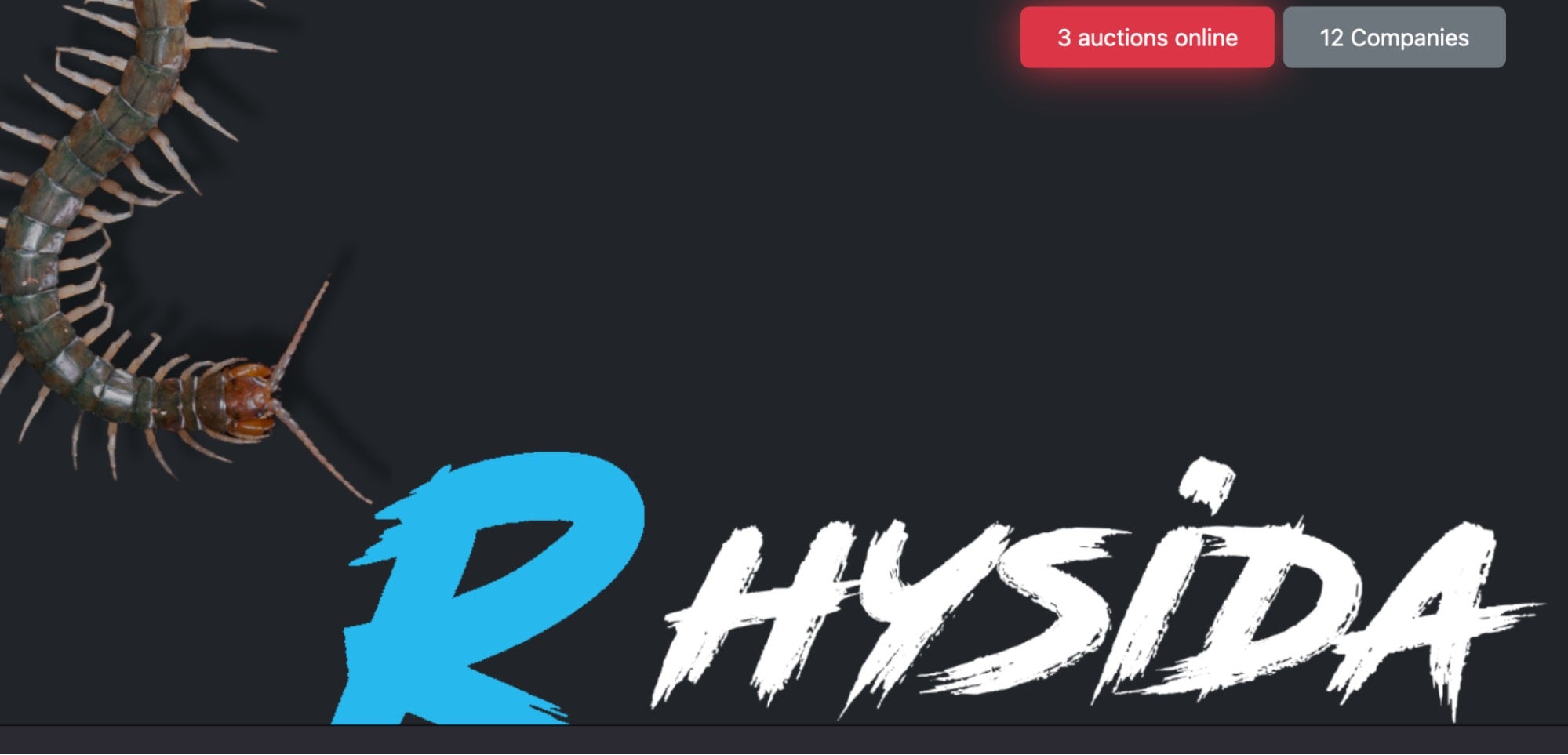
An Apache configuration status page reveals that the web server hosting the portal was first set up in March 2023. The group has since migrated their blog to a more ‘hardened’ instance of nginx, and these server configuration details and status are no longer visible. This move may have been prompted by the original IP address being exposed across various underground forums and markets.
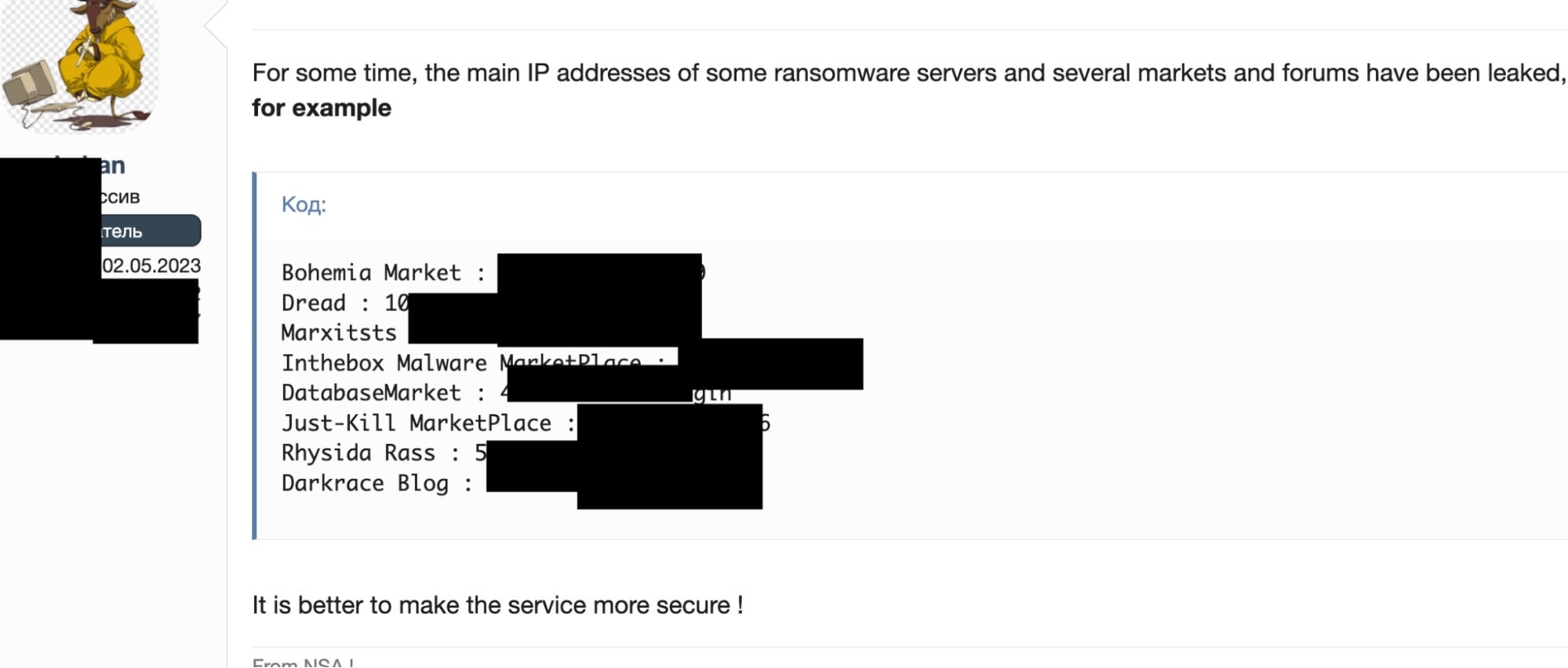
Rhysida is a privately marketed RaaS without known forum presence. The group positions themselves as a “cybersecurity team” who are doing their victims a favor by targeting their systems and highlighting the potential ramifications of the involved security issues. The group threatens victims with public distribution of the exfiltrated data, bringing them in line with modern-day multi-extortion groups.
The groups website also serves as a portal for Rhysida-centric news and media coverage, as well as details on how to contact the group should journalists, recovery firms or “fans” be inclined to do so.
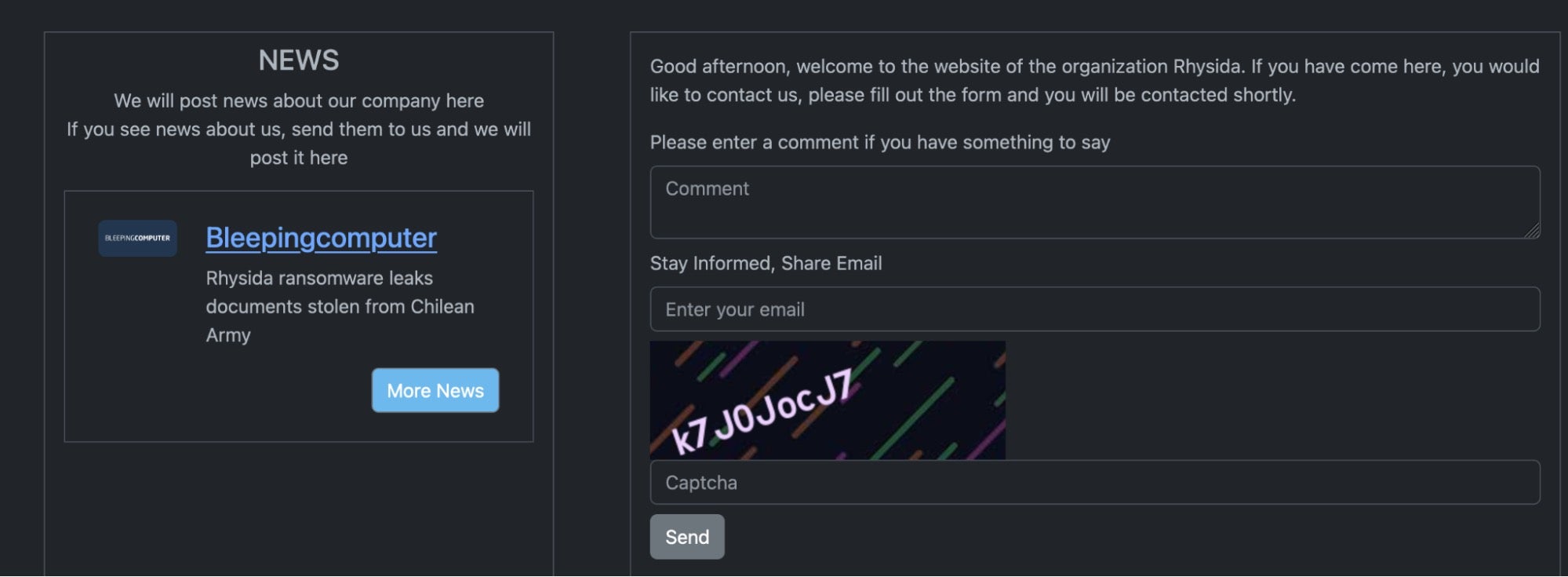
Victims are instructed to contact the attackers via their TOR-based portal, utilizing their unique identifier provided in the ransom notes. Rhysida accepts payment in Bitcoin only, providing information on the purchase and use of BTC on the victim portal as well. Upon providing their unique ID to the payment portal, an additional form is presented that allows victims to provide additional information to the attackers, such as authentication and contact details.
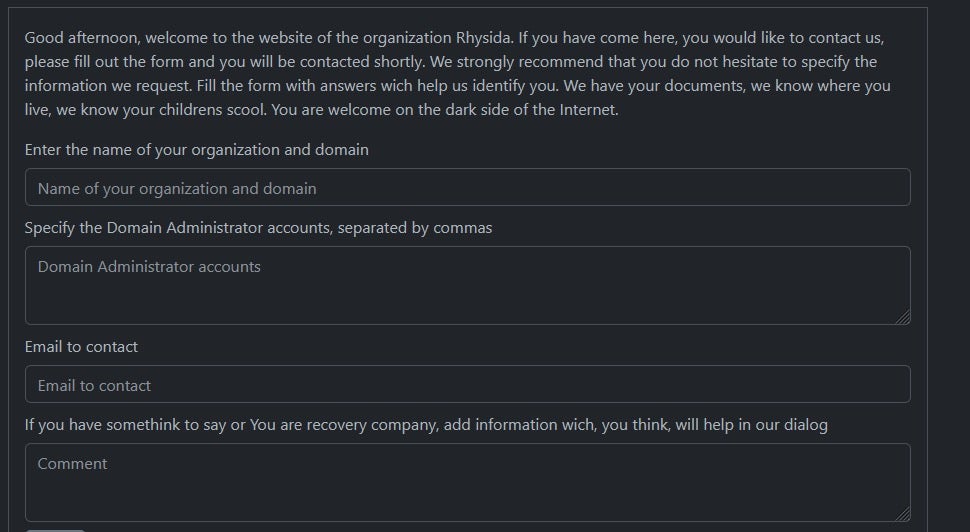
Technical Details
Rhysida is a 64-bit Portable Executable (PE) Windows cryptographic ransomware application compiled using MINGW/GCC. In each sample analyzed, the application’s program name is set to Rhysida-0.1, suggesting the tool is in early stages of development.
A notable characteristic of the tool is its plain-text strings revealing registry modification commands.
Rhysida Encryption & File Processing
For encryption, Rhysida uses a 4096-bit RSA key with the ChaCha20 algorithm. Its main function initializes the ransomware’s overall runtime, including encryption specifics. The main function contains several nested if-else conditions that handle arguments that specify different encryption implementations. The processFileEnc function contains code blocks for other encryption methods, including Rijndael, though the preceding functions are prefixed “test”.
processFileEnc calls init_prng, which initializes the encryption routine’s pseudo-random number generator that is passed to the chacha_crypt function.
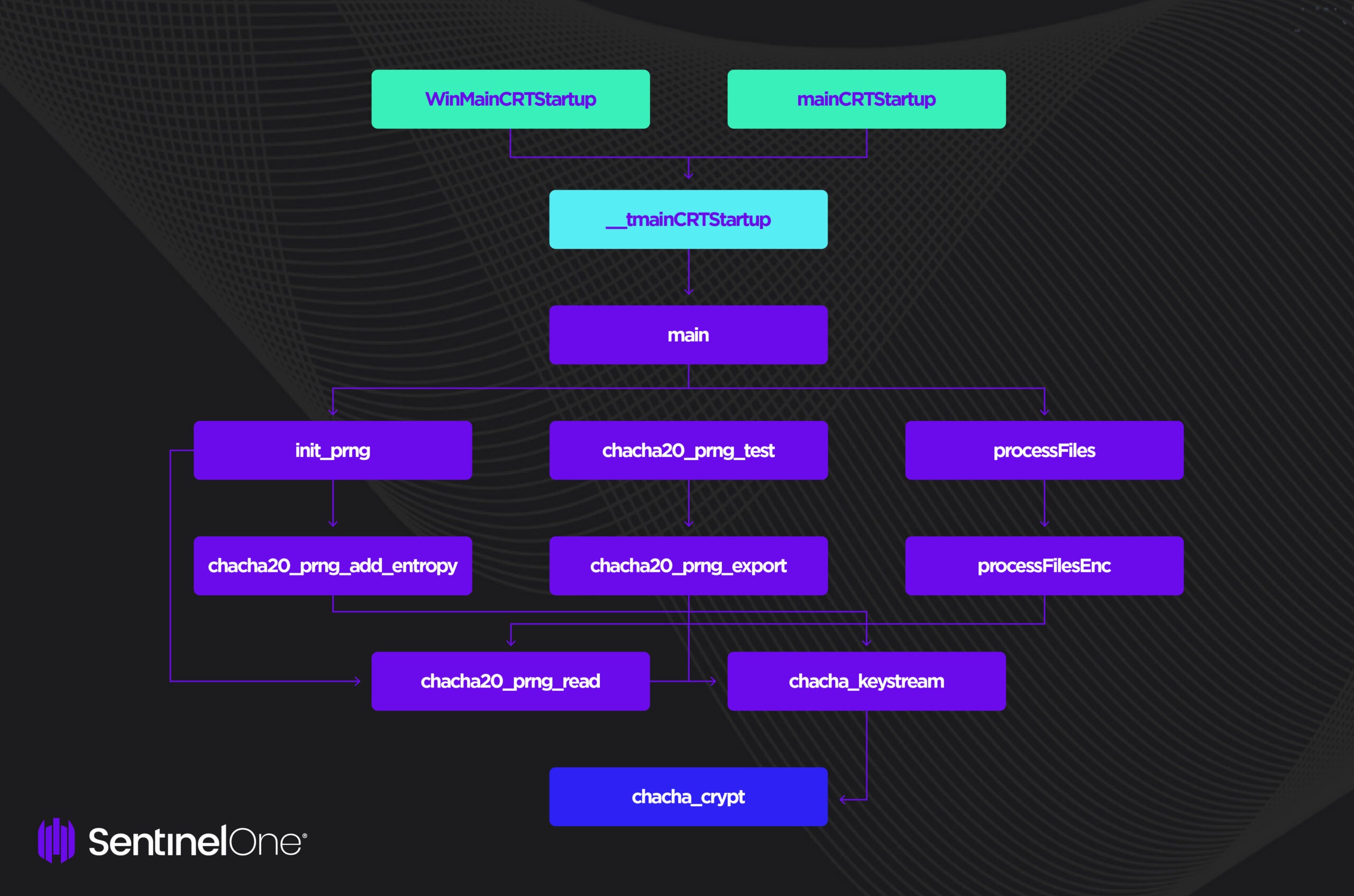
The processFileEnc function contains code that lists files and parses the current file name. Following encryption, Rhysida appends the .rhysida extension to the name of encrypted files.
After the encryption details are established, Rhysida enumerates files and folders connected to the system. The main function ends by calling PowerShell to delete the binary after encryption has completed.
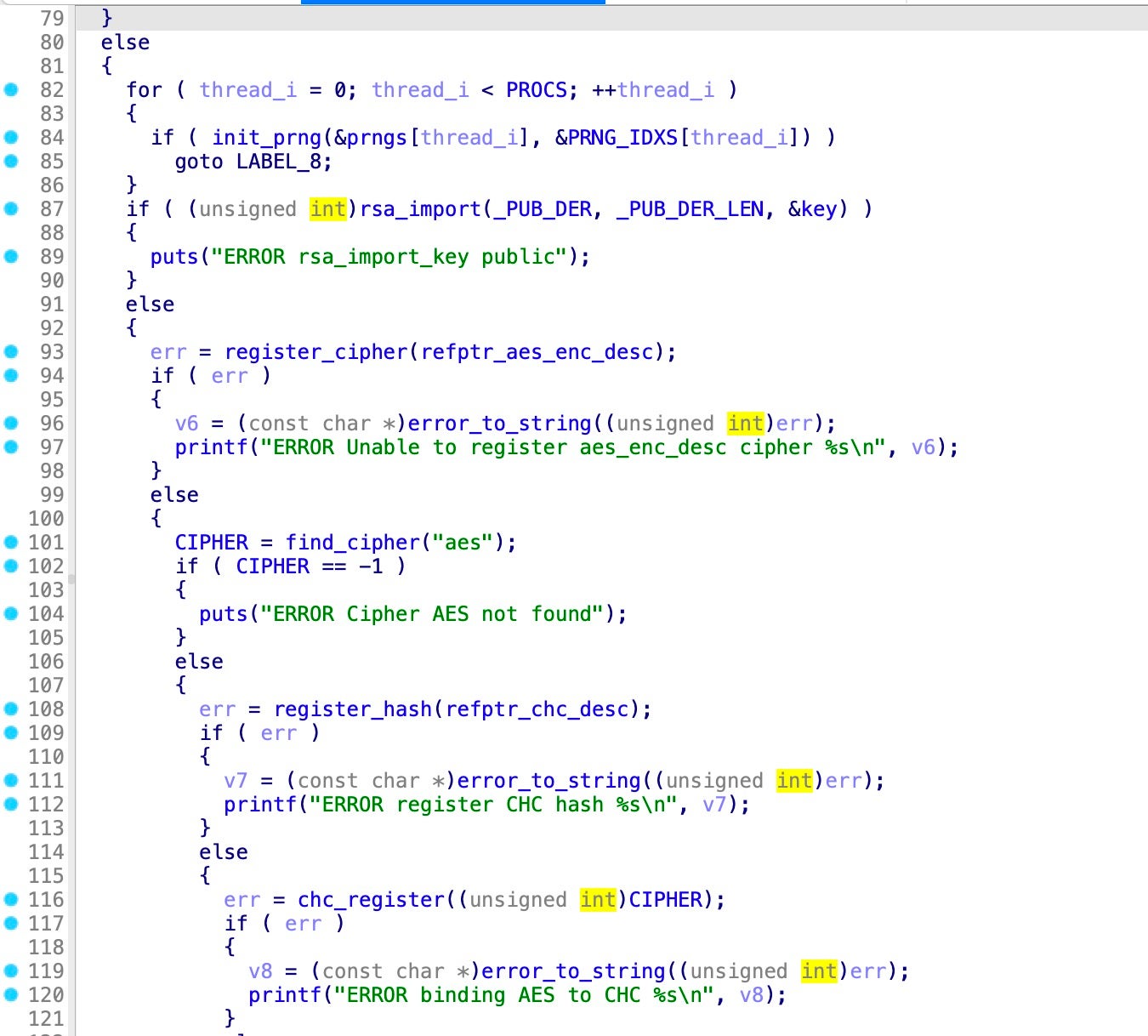
Rhysida uses a file exclusion list to avoid encrypting certain files. This check occurs in the isFileExcluded function, which compares the current file extension against exclude_extensions, an array that contains the following excluded file extensions:
[ bat, bin, cab, cmd, com, cur, diagcab, diagcfg, diagpkg, drv, dll, exe, hlp, hta, ico, ini, iso, lnk, msi, ocx, ps1, psm1, scr, sys, Thumbs-db, url ]
This function initializes two variables, exclude_i as 0 and exclude_c as 11, which iterate through the array of 27 excluded file extensions and the length of the current file name.
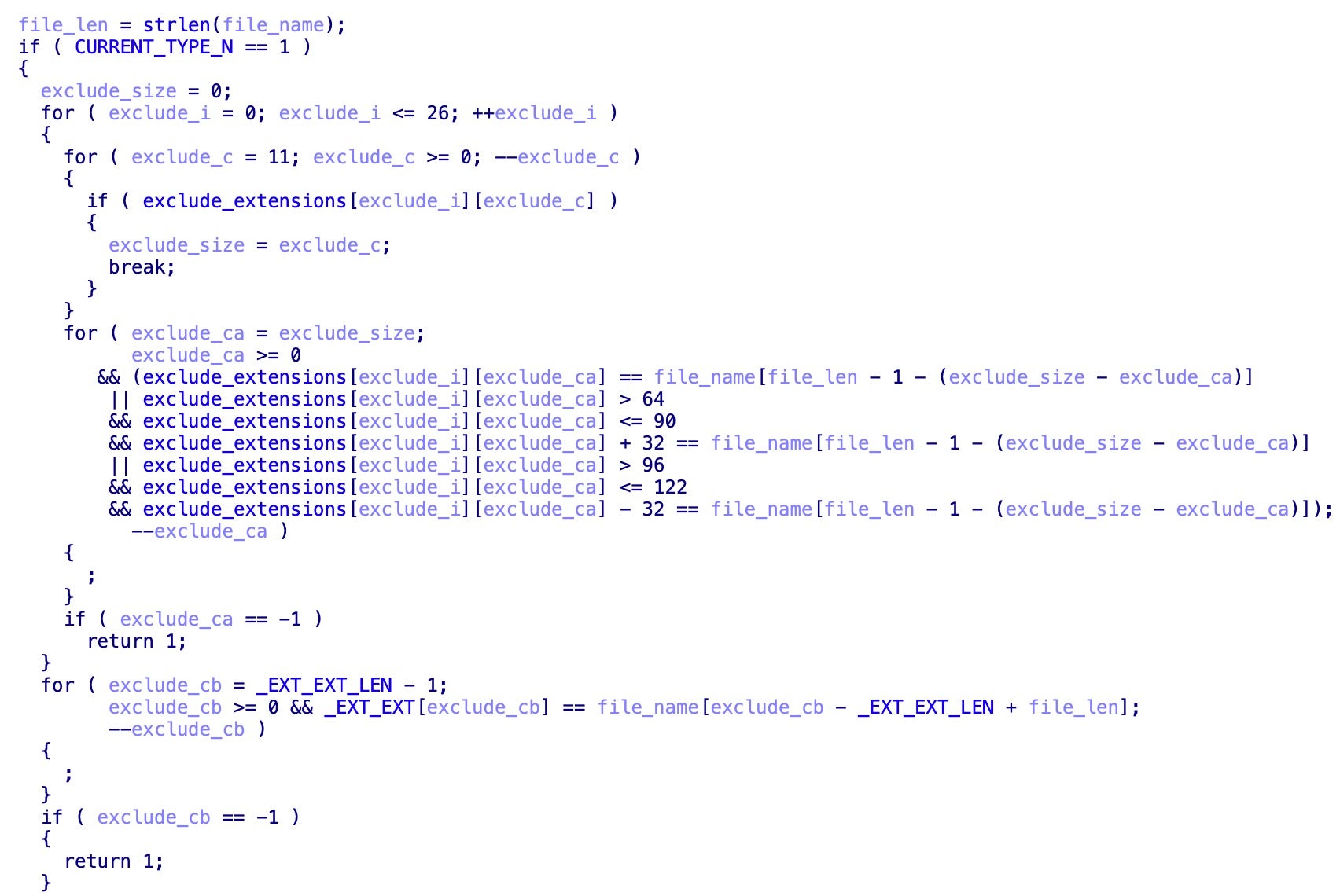
Extended features, beyond encrypting files, are still not present in current variations of Rhysida. The most recent of analyzed samples continue to lack commodity features like VSS Removal, multiple persistence mechanisms, process termination or unhooking.
Ransom Note & Victim Notification
Rhysida generates the ransom note as a PDF document. The content of the doc is embedded in the binary in clear text. This is a missed opportunity for the actors: PDF is a powerful document format that enables data to be encoded in many ways, often not in clear text. If the developer embeds the PDF object within the binary instead of constructing the PDF at runtime from unencrypted strings, Rhysida would evade string-based detection based on ransom note language.
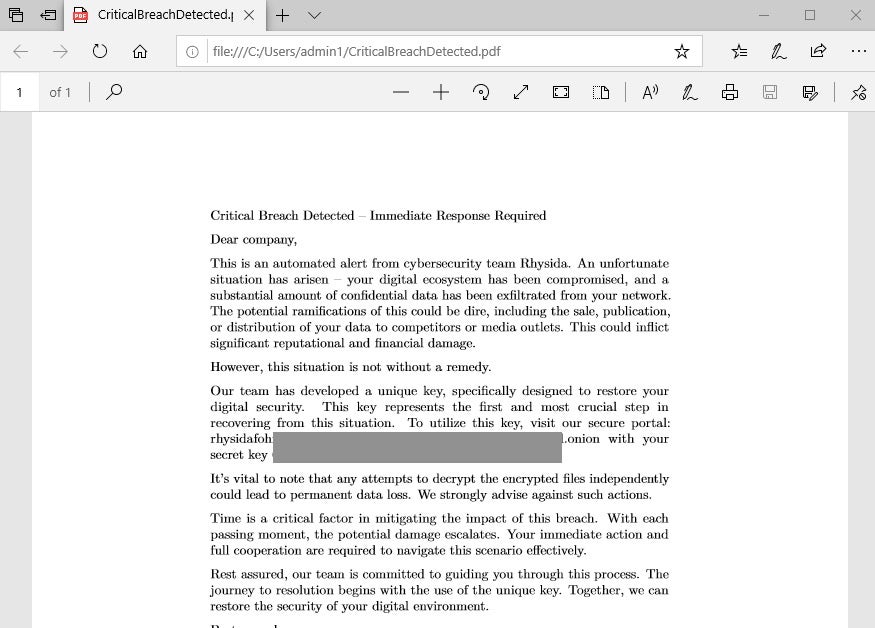
Rhysida’s setBG function is designed to create a new image, write it to C:\Users\Public\bg.jpg, and run registry modifications via cmd.exe to change the wallpaper and prevent the victim’s ability to change it. During SentinelOne’ analysis, this process did not execute successfully and the JPG is not written to disk.
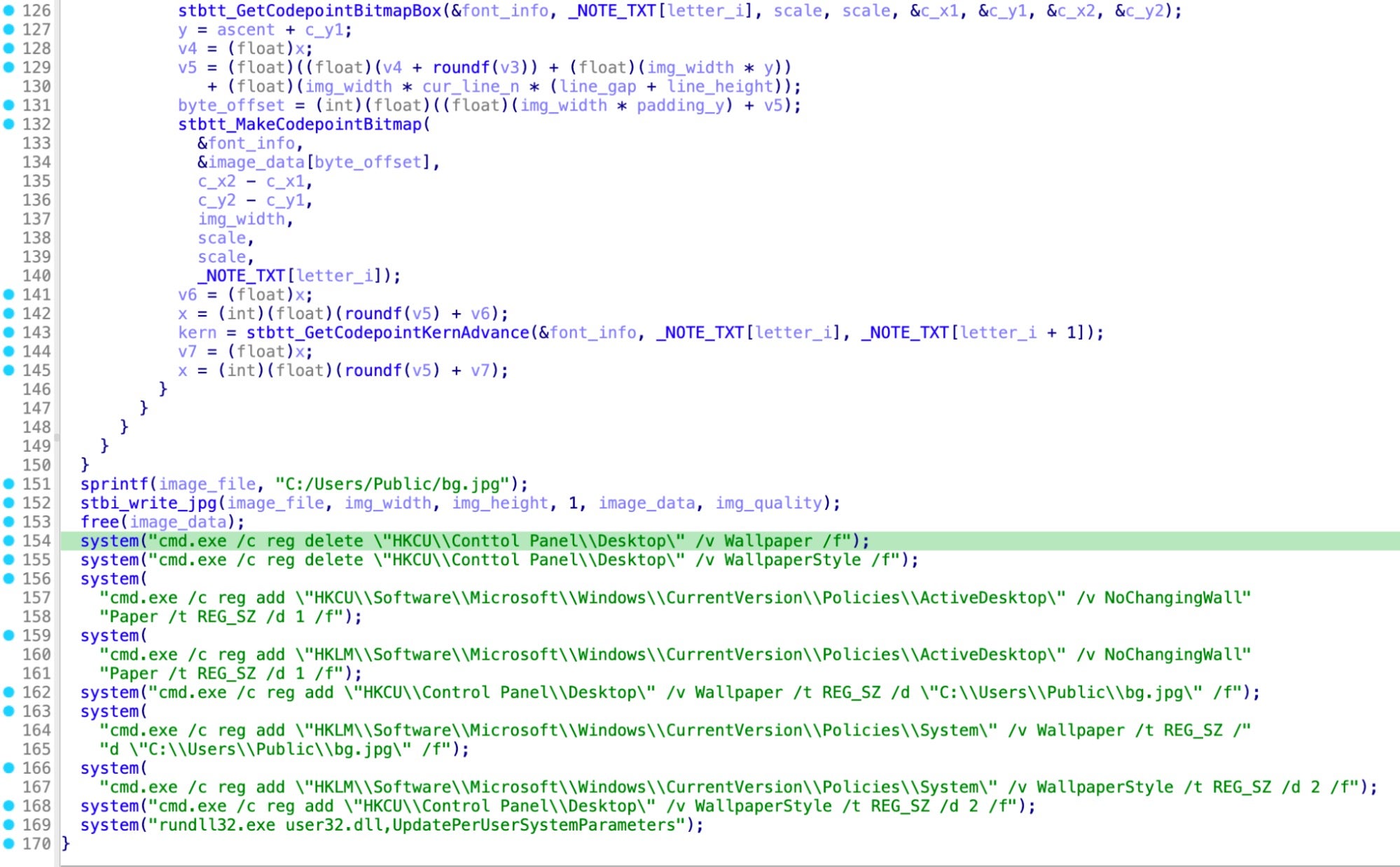
The setBG function pulls elements from the PDF ransom note and allocates them to a buffer, which then is inserted into a new JPG image. The developer misspelled Control Panel as Conttol Panel in two of the registry modification commands. We patched the binary to correct the spelling, but the wallpaper still did not change.
It is of note that this misspelling flaw persists across versions of Rhysida. Original versions (example: 69b3d913a3967153d1e91ba1a31ebed839b297ed) compiled on May 15, 2023 as well as the sample associated with the Chilean Army attack (338d4f4ec714359d589918cee1adad12ef231907, compiled on May, 27, 2023) each contain this issue.
SentinelOne Protects Against Rhysida Ransomware
The SentinelOne Agent detects Rhysida ransomware and prevents execution and file encryption.
For details about Rhysida and other ransomware families, visit SentinelOne’s Ransomware Anthology page.
Conclusion
Rhysida represents an unusual combination of techniques that suggest the developer is thinking outside the confines of contemporary ransomware. Features like the PDF ransom note could be leveraged for enhanced stealth, while the wallpaper changing feature is quite obtrusive, though not yet functional.
There are hallmarks of a less seasoned actor, such as the unobfuscated registry modification and PowerShell commands seen throughout the program. However, these are cosmetic fixes. Time will tell whether the developer’s choice to omit ubiquitous features, such as VSS copy deletion, will pay off or be supplemented through tools outside of the Rhysida application.
Indicators of Compromise (IOC)
| SHA1 | Description |
| 69b3d913a3967153d1e91ba1a31ebed839b297ed | Rhysida PE first reported by MalwareHunterTeam |
| 338d4f4ec714359d589918cee1adad12ef231907 | Rhysida PE used in attack against Chilean Army |
| b07f6a5f61834a57304ad4d885bd37d8e1badba8 | Rhysida PE, crashes during analysis |
YARA Hunting Rule
SentinelOne is providing the following YARA rule that defenders can use to identify Rhysida ransomware binaries.
rule rw_rhysida {
meta:
author = "Alex Delamotte"
description = "Rhysida ransomware detection."
sample = "69b3d913a3967153d1e91ba1a31ebed839b297ed"
reference = "https://s1.ai/rhys"
strings:
$typo1 = { 63 6D 64 2E 65 78 65 20 2F 63 20 72 65 67 20 64 65 6C 65 74 65 20 22 48 4B 43 55 5C 43 6F 6E 74 74 6F 6C 20 50 61 6E 65 6C 5C 44 65 73 6B 74 6F 70 22 }
$cmd1 = { 63 6D 64 2E 65 78 65 20 2F 63 20 72 65 67 20 61 64 64 20 22 48 4B 43 55 5C 53 6F 66 74 77 61 72 65 5C 4D 69 63 72 6F 73 6F 66 74 5C 57 69 6E 64 6F 77 73 5C 43 75 72 72 65 6E 74 56 65 72 73 69 6F 6E 5C 50 6F 6C 69 63 69 65 73 5C 41 63 74 69 76 65 44 65 73 6B 74 6F 70 }
$cmd2 = { 63 6D 64 2E 65 78 65 20 2F 63 20 72 65 67 20 61 64 64 20 22 48 4B 4C 4D 5C 53 6F 66 74 77 61 72 65 5C 4D 69 63 72 6F 73 6F 66 74 5C 57 69 6E 64 6F 77 73 5C 43 75 72 72 65 6E 74 56 65 72 73 69 6F 6E 5C 50 6F 6C 69 63 69 65 73 5C 53 79 73 74 65 6D 22 20 2F 76 20 57 61 6C 6C 70 61 70 65 72 20 2F 74 20 52 45 47 5F 53 5A 20 2F 64 20 22 43 3A 5C 55 73 65 72 73 5C 50 75 62 6C 69 63 5C 62 67 2E 6A 70 67 22 20 2F 66 }
$byte1 = { 48 8D 05 72 AA 05 00 48 8B 00 8B 95 }
$byte2 = { 48 8D 15 89 CF 03 00 48 89 C1 E8 F9 1C 03 00 44 }
condition:
2 of them
}


